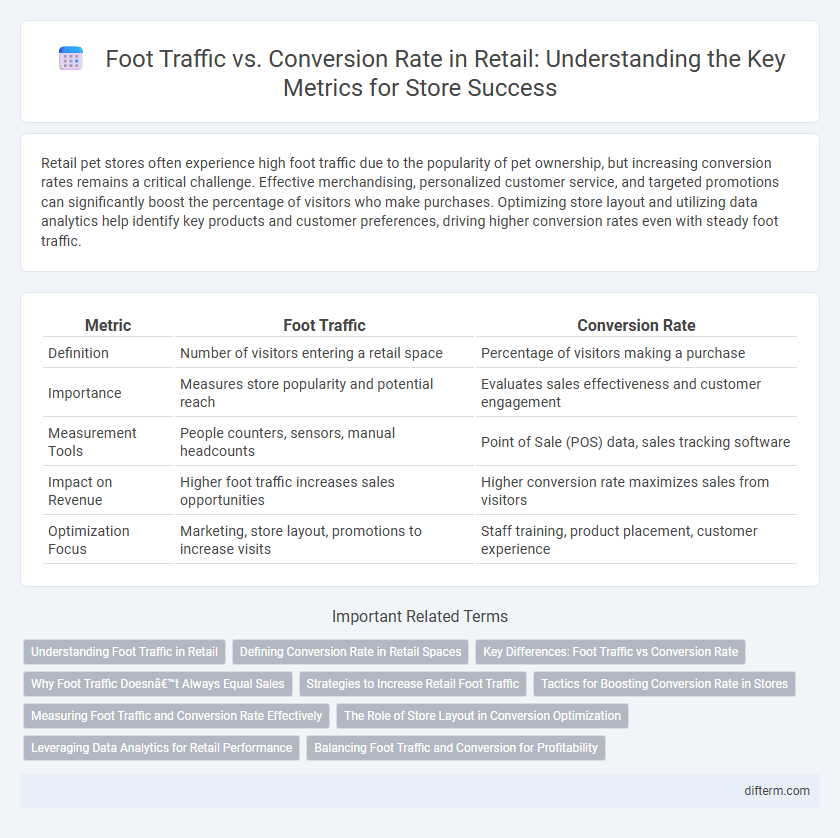Retail pet stores often experience high foot traffic due to the popularity of pet ownership, but increasing conversion rates remains a critical challenge. Effective merchandising, personalized customer service, and targeted promotions can significantly boost the percentage of visitors who make purchases. Optimizing store layout and utilizing data analytics help identify key products and customer preferences, driving higher conversion rates even with steady foot traffic.
Table of Comparison
| Metric | Foot Traffic | Conversion Rate |
|---|---|---|
| Definition | Number of visitors entering a retail space | Percentage of visitors making a purchase |
| Importance | Measures store popularity and potential reach | Evaluates sales effectiveness and customer engagement |
| Measurement Tools | People counters, sensors, manual headcounts | Point of Sale (POS) data, sales tracking software |
| Impact on Revenue | Higher foot traffic increases sales opportunities | Higher conversion rate maximizes sales from visitors |
| Optimization Focus | Marketing, store layout, promotions to increase visits | Staff training, product placement, customer experience |
Understanding Foot Traffic in Retail
Foot traffic in retail refers to the number of customers entering a store during a specific period, serving as a key indicator of potential sales opportunities. Analyzing foot traffic patterns helps retailers identify peak shopping times, optimize staffing, and enhance product placement to attract more visitors. Monitoring foot traffic enables better inventory management and targeted marketing strategies, ultimately driving higher conversion rates and revenue growth.
Defining Conversion Rate in Retail Spaces
Conversion rate in retail spaces measures the percentage of visitors who make a purchase after entering the store, serving as a crucial indicator of sales effectiveness. It is calculated by dividing the number of transactions by total foot traffic and multiplying by 100 to get a percentage. Understanding conversion rate helps retailers optimize store layout, marketing strategies, and customer experience to maximize revenue from existing foot traffic.
Key Differences: Foot Traffic vs Conversion Rate
Foot traffic measures the total number of visitors entering a retail store, while conversion rate indicates the percentage of those visitors who make a purchase. High foot traffic alone does not guarantee sales, as a low conversion rate can signify issues with product appeal or customer service. Understanding the balance between foot traffic and conversion rate is crucial for optimizing store performance and increasing revenue.
Why Foot Traffic Doesn’t Always Equal Sales
High foot traffic indicates store popularity but doesn't guarantee increased sales due to factors like poor customer engagement, product mismatch, or inefficient store layout. Conversion rate is a critical metric that measures the percentage of visitors who make a purchase, directly reflecting sales effectiveness. Retailers must optimize in-store experience and merchandising strategies to convert high foot traffic into actual revenue rather than relying solely on visitor numbers.
Strategies to Increase Retail Foot Traffic
Implementing targeted local advertising and leveraging social media promotions significantly boost retail foot traffic by attracting neighborhood consumers. Enhancing in-store experiences through interactive displays and personalized customer service encourages longer visits and repeat traffic. Collaborating with local events and offering exclusive time-limited products also drive immediate increases in store visits.
Tactics for Boosting Conversion Rate in Stores
Enhancing in-store conversion rates requires targeted tactics such as optimized product placements, personalized customer interactions, and streamlined checkout processes. Utilizing heat maps and foot traffic analytics helps identify high-engagement zones for strategic merchandising, increasing the likelihood of purchase. Training staff to deliver exceptional service and deploying digital kiosks for quick product information further convert foot traffic into sales, maximizing retail revenue.
Measuring Foot Traffic and Conversion Rate Effectively
Measuring foot traffic accurately involves using technologies such as infrared sensors, video analytics, and Wi-Fi tracking to count visitors entering retail locations, providing real-time data on customer flow patterns. Conversion rate is calculated by dividing the number of transactions by the total foot traffic, offering a clear metric of store performance and sales efficiency. Integrating these measurements with point-of-sale data and customer behavior analytics enhances decision-making for optimizing store layouts, staffing, and marketing strategies.
The Role of Store Layout in Conversion Optimization
Store layout design directly influences foot traffic flow and enhances conversion rates by guiding customers through high-impact product areas and minimizing navigation obstacles. Strategic placement of merchandise and optimized aisle spacing encourage longer browsing times, increasing the likelihood of purchases. Retailers leveraging data-driven spatial arrangements see measurable improvements in conversion optimization by aligning store layout with shopper behavior patterns.
Leveraging Data Analytics for Retail Performance
Retailers leveraging data analytics can optimize foot traffic patterns by identifying peak periods and high-traffic zones, enabling targeted staffing and inventory placement. Analyzing conversion rates alongside foot traffic data reveals critical insights into store layout effectiveness and marketing campaign success, driving precise strategy adjustments. Utilizing real-time data empowers retailers to enhance customer experiences and maximize sales efficiency in dynamic retail environments.
Balancing Foot Traffic and Conversion for Profitability
Maximizing retail profitability requires balancing high foot traffic with an optimized conversion rate to ensure visitors translate into sales. Retailers must use data analytics to identify peak traffic times and improve in-store customer experiences, which increases the likelihood of purchases. Investing in targeted marketing and staff training enhances conversion rates, turning foot traffic into sustainable revenue growth.
Foot Traffic vs Conversion Rate Infographic

 difterm.com
difterm.com